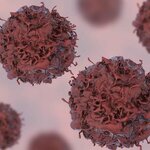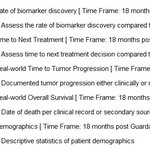Cancer Research

Smoking is a legitimate class 1 carcinogen, determined by the International Agency for Research on Cancer before they were hijacked by activist epidemiologists out to scare people about the modern world.
Yet it is not a magic bullet. Only 10 percent of smokers will get lung cancer, which does not sound like a lot, but it is actually a high amount - greater than alcohol or obesity. Yet it is so obviously toxic it seems like the cancer rates should be much higher.
What saves some people may be bronchial basal cells. It's only a pilot study but intriguing. Using single-cell multiple…

A recent trial of lamivudine, a reverse transcriptase inhibitor used in HIV therapy, found that it stopped disease progression in patients with fourth-line metastatic colorectal cancer.
The trial included 32 patients with advanced metastatic colon cancer whose disease progressed despite four lines of previous cancer treatments. The first nine patients received the standard HIV-approved dose of lamivudine. After adjusting the dosing four-fold, another 23 patients received lamivudine therapy where it was highly tolerated.
“After giving them only this one drug – nothing else – we saw signs…

Cancer deaths rose to 10 million globally in 2019, up from 2010 when total cancer deaths numbered 8.29 million worldwide - but the headline masks some important health progress.
Cancer is not going up, despite claims by those who believe modern food, energy, and medicine are harming us. Diagnoses are going up, which means deaths are now more successfully categorized than in the past. And tracheal, bronchus, and lung cancer, the leading causes, will decline as the inroads America has made against smoking propagate throughout Europe and developing nations.
Instead of there being more…

In a new epidemiology paper, men taking cholesterol-lowering statin drugs had different prostate cancer screening results than non-users - in statin users, screening did not increase the incidence of prostate cancer as it did in other men.
The data came from the Finnish Prostate Cancer Screening Trial which started in 1996–1999. A total of about 80,000 men were included in the study, of whom just under 32,000 were screened with the PSA test every four years.
The clearest difference was in low-risk cancer, which is often over-diagnosed due to screening. The number of low-risk…

Pancreatic cancer tends to develop from chronic inflammation that happens when a mutation has caused digestive enzymes to digest the pancreas itself.
What if we could go 'back in time' and reverse that process?
Purdue University Professor Bumsoo Han and his team built is a lifelike reproduction of a pancreatic structure called the acinus, which produces and secretes those digestive enzymes into the small intestine. The goal is reprogram the cancerous acinar cells that produce those enzymes, and perhaps completely reset the pancreas.
The reset button might a gene called PTF1a. It's vital…

Like coronavirus, Hepatitis C was only discovered as unique a few decades ago, but in that time science took its 2 million new HCV infections every year, with an estimated 70 million carriers of the virus globally, and 400,000 deaths annually to finding a cure.
Directly acting antivirals (DAAs) can now stop it and therefore prevent the liver cirrhosis and liver cancer that can develop. Next up, said Professor Sir Michael Houghton at the European Society of Clinical Microbiology and Infectious Diseases, who won the Nobel Prize for Medicine and Physiology along with three other scientists…

As we exit the worst of the COVID-19 pandemic, the health care community must consider how to apply lessons learned over the past year to improve quality of care and patient outcomes across the health care spectrum. One critical advancement made during COVID was the growing reliance on the life-saving power of Real-World Evidence (RWE) – enabled by the widespread adoption of electronic health records (EHRs), the availability of diverse data sets, and advancements in analytics – all of which allowed researchers to gather data from everyday healthcare settings and collect real-time…

Preclinical findings suggest that targeting the mitochondrial enzyme dihydroorotate dehydrogenase (DHODH) can restore ferroptosis-driven cell death, pointing to new therapeutic strategies that may be used to induce ferroptosis and inhibit tumor growth.
Ferroptosis is a form of controlled cell death triggered by the toxic accumulation of lipid peroxides in the cell. Because lipid peroxides are generated through normal metabolic activities, cells also have mechanisms in place to defend against ferroptosis. Glutathione peroxidase 4 (GPX4) is one of the key defense mechanisms identified to date.…

The current pandemic has changed the way we live our lives. Every aspect of human interaction has been affected. Our daily lives have undergone dramatic adjustments that may have been hard to imagine in the period prior to the pandemic.
Colon cancer screening has been witnessing a change in the midst of this pandemic. COVID-19 has resulted in a drop in screening rates for colorectal cancer. Not just in the US but in other countries across the globe.
An opinion piece in JAMA elaborated on the use of fecal immunochemical testing or FIT kits to screen for colon cancer in the United States.…

As medical care has improved, doctors are able to screen for cancer earlier than ever, and that is why cancer cases in young adults and adolescents are prevalent enough that they can be considered a distinct population.
Age remains the biggest factor for everything, of course, if you live long enough you are going to get cancer of some kind, it is built into our biology, but the increase in screening and therefore diagnoses means young adults can be considered distinct from pediatric and adult cancers and have their own middle ground for research.
An analysis of adolescents and young adults…